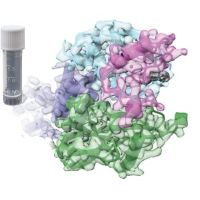Specification
| Description | Recombinant protein from the full-length sequence of homo sapiens arginase 2 (ARG2) (NM_001172). |
| Organism | Homo sapiens (Human) |
| Expression Host | Human Cells |
| Tag Info | His or DYKDDDDK. Please contact us if you need further information or require specific designed tag. |
| Purity | Greater than 90% by SDS-PAGE gel |
| Uniprot ID | P78540 |
| Entry Name | ARGI2_HUMAN |
| Gene Names | ARG2 |
| Alternative Gene Names | |
| Alternative Protein Names | Arginase-2, mitochondrial (EC 3.5.3.1) (Arginase II) (Kidney-type arginase) (Non-hepatic arginase) (Type II arginase) |
| Application | Antigens, Western, ELISA and other in vitro binding or in vivo functional assays, and protein-protein interaction studies; For research & development use only! |
| Buffer | Purified protein formulated in a sterile solution of PBS buffer, pH7.2, without any preservatives |
| Endotoxin | Endotoxin level is < 0.1 ng/µg of protein (<1EU /µg) |
| Length | 354 |
| Molecular Weight(Da) | 38578 |
| Protein Sequence | (The sequence of expressed protein may have some variation from the sequence shown below. Please contact us for the exact sequence.) MSLRGSLSRLLQTRVHSILKKSVHSVAVIGAPFSQGQKRKGVEHGPAAIREAGLMKRLSSLGCHLKDFGDLSFTPVPKDDLYNNLIVNPRSVGLANQELAEVVSRAVSDGYSCVTLGGDHSLAIGTISGHARHCPDLCVVWVDAHADINTPLTTSSGNLHGQPVSFLLRELQDKVPQLPGFSWIKPCISSASIVYIGLRDVDPPEHFILKNYDIQYFSMRDIDRLGIQKVMERTFDLLIGKRQRPIHLSFDIDAFDPTLAPATGTPVVGGLTYREGMYIAEEIHNTGLLSALDLVEVNPQLATSEEEAKTTANLAVDVIASSFGQTREGGHIVYDQLPTPSSPDESENQARVRI |
Background
| Function | FUNCTION: May play a role in the regulation of extra-urea cycle arginine metabolism and also in down-regulation of nitric oxide synthesis. Extrahepatic arginase functions to regulate L-arginine bioavailability to nitric oxid synthase (NOS). Arginine metabolism is a critical regulator of innate and adaptive immune responses. Seems to be involved in negative regulation of the survival capacity of activated CD4(+) and CD8(+) T cells (PubMed:27745970). May suppress inflammation-related signaling in asthmatic airway epithelium (PubMed:27214549). May contribute to the immune evasion of H.pylori by restricting M1 macrophage activation and polyamine metabolism (By similarity). In fetal dendritic cells may play a role in promoting immune suppression and T cell TNF-alpha production during gestation (PubMed:28614294). Regulates RPS6KB1 signaling, which promotes endothelial cell senescence and inflammation and implicates NOS3/eNOS dysfunction (PubMed:22928666). Can inhibit endothelial autophagy independently of its enzymatic activity implicating mTORC2 signaling (PubMed:25484082). Involved in vascular smooth muscle cell senescence and apoptosis independently of its enzymatic activity (PubMed:23832324). Since NOS is found in the penile corpus cavernosum smooth muscle, the clitoral corpus cavernosum and the vagina, arginase-2 plays a role in both male and female sexual arousal (PubMed:12859189). {ECO:0000250|UniProtKB:O08691, ECO:0000269|PubMed:12859189, ECO:0000269|PubMed:22928666, ECO:0000269|PubMed:23832324, ECO:0000269|PubMed:25484082, ECO:0000269|PubMed:27214549, ECO:0000269|PubMed:27745970}. |
| Pathway | Nitrogen metabolism; urea cycle; L-ornithine and urea from L-arginine: step 1/1. |
| Protein Families | Arginase family |
| Tissue Specificity | Expressed most strongly in kidney and prostate, much less strongly in the brain, skeletal muscle, placenta, lung, mammary gland, macrophage, uterus, testis and gut, but apparently not in the liver, heart and pancreas. Expressed in activated T cells (PubMed:27745970). {ECO:0000269|PubMed:27745970}. |
QC Data
| Note | Please contact us for QC Data |
| Product Image (Reference Only) |  |

